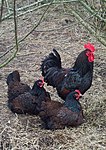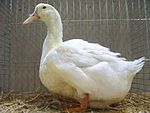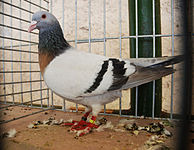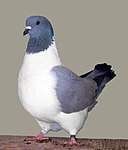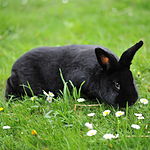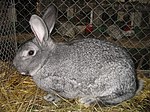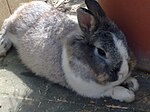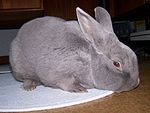List of endangered livestock breeds
The list of endangered farm animal breeds gives an overview of breeds of farm animals that are native to Germany or Austria and are classified as endangered there.
Basics of the lists
Germany
In Germany , the Society for the Conservation of Old and Endangered Domestic Animal Breeds (GEH) has been publishing a red list of endangered farm animal breeds in Germany every year since the 1980s . The hazard categories are “extremely endangered”, “highly endangered”, “endangered”, “monitoring of the population” and “only individual animals”. A breed is classified as endangered if the population falls below the minimum number ( horses , pigs , goats , donkeys : 5000 animals; sheep : 1500 animals; cattle : 7,500 animals) and decreases by an average of at least 10% over a period of two years. The classification into the hazard categories is carried out by experts taking into account the development of the population and its prognosis.
As part of the specialist program for the conservation and sustainable use of animal genetic resources , which was adopted in 2003 by the Conference of Agriculture Ministers of the Federal and State Governments , the Federal Office for Agriculture and Food (BLE) runs the Central Documentation of Animal Genetic Resources in Germany (TGRDEU), which is freely available online. with classification in categories according to the threat to the existence of the company. A red list compiled from this data is available to the public as a red list of endangered domestic livestock breeds in Germany . The hazard categories are
- "PERH" (phenotypic conservation population: indisputable cultural value, but only rudiments ),
- "ERH" (maintenance population),
- "BEO" (observation population),
- "NG" (not endangered).
The categorization takes place via the effective population size , which is calculated from the number of female and male animals. In some cases, a different classification (marked with *) is carried out, taking additional technical aspects into account. The list includes horses, cattle, sheep, pigs, goats, and donkeys. For the types of poultry ( chicken , goose , duck , turkey ), a joint red list of old, native and endangered poultry breeds was drawn up in 2006 by the Bund deutscher Rassegeflügelzüchter (BDRG) and the GEH , which was included in the list of the BLE. There are five hazard categories (Category I = highest hazard). The expansion to other livestock species such as rabbits , dogs and bees is sought.
This list includes the breeds that are classified as endangered in the brochure of the BLE (status: 2008), in the TGRDEU or by the GEH. In Germany, the Diverse Initiative for the Conservation of Old and Endangered Domestic Animal Breeds (VIEH) publishes a red list on which foreign breeds are also mentioned. Every year all livestock arks are recorded in Germany and abroad. The current and previous stock figures of the contract centers are published.
Austria
In Austria, the Austrian National Association for Gene Reserves (ÖNGENE) is dedicated to taking stock of endangered domestic livestock breeds and takes measures to preserve the endangered breeds. In addition, the Arche Austria - Association for the Preservation of Rare Livestock Breeds , which actively tries to preserve endangered livestock species in Austria, also keeps a list of endangered breeds. This list also includes the endangered breeds named by ÖNGENE and some additional ones from Arche Austria.
Large animals
52 of 74 indigenous breeds of the five large animal species are classified as endangered by the Animal Genetic Resources Advisory Board in Germany.
The mentioned hazard categories of the Federal Ministry of Agriculture and Food have been defined as follows since 2013.
- Phenotypic Maintenance Populations (PERH)
Breeds in this endangerment category “can only be understood as rudiments from an animal breeding point of view.” However, their cultural value is undisputed. The existing animal population cannot be clearly traced back to the original breed in terms of genetics. When it was re-established, the breed was already strongly mixed with other breeds, had declined to very few animals or had only very small population sizes over several generations.
- Maintenance Populations (ERH)
For these breeds, special breeding programs for genetic preservation are developed, cryo reserves are set up and monitoring is carried out. Reasons for a deviation from the calculated lower estimated risk can be a local distribution of the breed, a "very problematic breeder structure or the dynamics of the population decline".
- Observation Population (BEO)
Cryo reserves are set up and monitoring carried out for races of the observation populations. If Ne arithmetically speaks for ERH, a classification in BEO can also be carried out "if the population is stable and an effective breeding program is used to maintain genetic variance."
- Non-Endangered Breeds (NG)
- Monitoring is carried out for non-endangered breeds. Deviations from the mathematically higher estimated risk may exist if a "new or synthetic breed is not consolidated in breeding and can be reactivated at any time by existing original breeds, the breed is not listed in its own stud book" or the breed is so widespread worldwide, that a hazard does not seem to exist.
Horses
| race | Illustration | Endangerment in Germany and Austria |
Existence in Germany and Austria |
|---|---|---|---|
| Old Austrian warmblood |
ÖNGENE: endangered, |
A: 4 stallions / 9 mares | |
| Arenberg-Nordkirchener pony |
GEH: extremely endangered |
D: 4 stallions / 18 mares (as of 2007) | |
German riding horse (breed group of populations):
|

|
|
Total: 2,726 stallions / 53,426 mares (2013) Ne = 9484
|
| German Riding Pony |

|
|
D: 714 stallions / 4,895 mares (2013) Ne = 2492 |
| Dülmen wild horse |

|
GEH: extremely endangered |
D: 15 stallions / 47 mares (2013) Ne = 45 |
| Hutsul |

|
ÖNGENE: endangered |
D: 2 stallions / 5 mares (2013) A: 19 stallions / 175 mares (Herd book 2009) |
| Lehmkuhlener pony |
GEH: extremely endangered |
D: 5 stallions / 16 mares (2012) | |
| Leutstettener |
GEH: extremely endangered |
D: 2 stallions / 20 mares (2018) Ne = 4 | |
| Lipizzaner |

|
ÖNGENE: endangered |
D: 27 stallions / 68 mares (2013) A: approx. 200, worldwide approx. 4000 |
| Noriker |

|
ÖNGENE: endangered |
D: 12 stallions / 44 mares (2013) A: 211 stallions / 4568 mares (Herd book 2009) |
| Palatinate-Ardennes cold blood |

|
|
D: 4 stallions / 21 mares (2013) Ne = 13 |
| Rhenish-German draft horse |
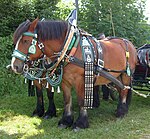
|
GEH: endangered |
D: 149 stallions / 1,173 mares (2013) Ne = 529 |
| Rottaler horse |
GEH: extremely endangered |
D: 9 stallions / 18 mares (2013) Ne = 24 | |
| Schleswig cold blood |

|
GEH: highly endangered |
D: 23 stallions / 170 mares (2013) Ne = 81 |
| Black Forest cold blood |

|
GEH: endangered |
D: 79 stallions / 979 mares (2013) Ne = 292 |
| Heavy warm-blooded animals (breed group of populations): |

|
GEH: extremely endangered - endangered |
Total: 93 stallions / 1,191 mares (2013) Ne = 345
|
| Dairyman horse |
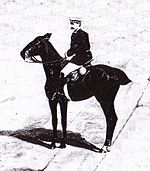
|
GEH: extremely endangered |
D: 6 stallions / 26 mares (2013) Ne = 19.5 |
| Shagya Arabs |

|
ÖNGENE: endangered |
A: 189 breeding animals (as of 2009) |
| South German cold blood |

|
|
D: 129 stallions / 1,921 mares (2013) Ne = 484 |
| Trotters |
|
D: 192 stallions / 421 mares (2013) Ne = 527 |
Bovine
| race | Illustration | Endangerment in Germany, Austria and Switzerland |
Existence in Germany and Austria |
|---|---|---|---|
|
Angler cattle of old breeding direction (Red cattle of old angler breeding direction) |
GEH: extremely endangered |
D: 10 bulls / 125 cows (2013) D: 30 bulls / 325 cows (2014) |
|
| Ansbach-Triesdorfer (Triesdorfer Tiger) |

|
GEH: extremely endangered |
D: 7 bulls / 77 cows (2013) |
| German black and white lowland cattle |
GEH: endangered |
D: 8 bulls / 2,722 cows (2013) | |
| German Shorthorn |
GEH: extremely endangered |
D: 20 bulls / 185 cows (2013) | |
| Double use of Red Holstein |

|
GEH: observation |
D: 14 bulls / 4,744 cows (2013) |
| Ennstaler Bergschecke |

|
ÖNGENE: highly endangered |
A: 236 animals (Herd book 2010) |
| Yellow cattle |

|
GEH: observation |
D: 4 bulls / 2,374 cows (2013) |
| Glan cattle |
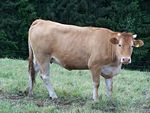
|
GEH: extremely endangered |
D: 106 bulls / 826 cows (2013) |
| Hinterwald cattle |

|
GEH: endangered |
D: 98 bulls / 521 cows (2013) D: 2,221 animals (2012) |
| Carinthian blond cattle |
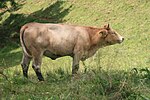
|
ÖNGENE: highly endangered |
A: 1627 animals (Herd book 2010) |
| Limpurger |

|
GEH: extremely endangered |
D: 26 bulls / 135 cows (2013) |
| Murbodner beef |
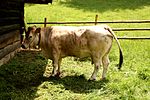
|
ÖNGENE: highly endangered |
A: 5214 animals (Herd book 2010) |
| Murnau-Werdenfelser |

|
GEH: extremely endangered |
D: 24 bulls / 216 cows (2013) D: 4 bulls / 27 cows (meat use, 2013) |
| Original Brown Swiss |

|
GEH: highly endangered Austria ÖNGENE: highly endangered |
D: 23 bulls / 569 cows (2013) A: 1601 animals (Herd book 2010) |
| Pinzgauer |
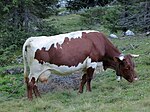
|
GEH: endangered Austria ÖNGENE: endangered |
D: 15 bulls / 729 cows (2013) D: 36 bulls / 594 cows (meat use, 2013) A: approx. 5100 animals (as of 2010) |
| Pustertal Sprinzen |

|
GEH: extremely endangered Austria ÖNGENE: highly endangered |
D: 69 animals (as of 2013) A: 584 animals (Herd book 2010) |
| Raetian gray cattle |

|
|
without disclosures |
| Red cattle |
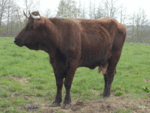
|
GEH: endangered |
D: 137 bulls / 1,527 cows (2013) |
| Tyrolean gray cattle |
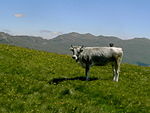
|
ÖNGENE: endangered |
A: approx. 4000 animals (as of 2010) |
| Tux-Zillertal beef |

|
ÖNGENE: highly endangered |
A: 1,965 animals (Herd book 2010) |
| Uckermarker |

|
|
D: 111 bulls / 3,896 cows (2013) |
| Front forests |
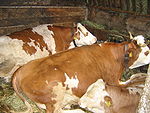
|
GEH: observation |
D: 238 bulls / 6,439 cows (2013) |
| Waldviertel Blondvieh |

|
ÖNGENE: highly endangered |
A: 1,736 animals (Herd book 2010) |
Sheep
| race | Illustration | Endangerment in Germany and Austria |
Existence in Germany and Austria |
|---|---|---|---|
| Bentheimer Landschaf |

|
GEH: endangered |
D: 117 bucks / 2,810 floodplains (2014) |
| Mountain sheep |

|
GEH: highly endangered Austria ÖNGENE: highly endangered |
D: 64 bucks / 1,176 floodplains (2014) A: 3,223 animals (Herd book 2010) |
| Mountain sheep: |
|
D: 23 bucks / 222 floodplains (2014) | |
| Mountain sheep: |
|
D: 6 bucks / 135 floodplains (2014) | |
| Mountain sheep: |
GEH: endangered |
D: 61 bucks / 1,563 floodplains (2014) | |
| Coburg fox sheep |

|
GEH: observation |
D: 231 bucks / 4,094 floodplains (2014) |
| German black-headed meat sheep |

|
|
D: 343 bucks / 8,868 floodplains (2014) |
| German white-headed meat sheep |

|
GEH: endangered |
D: 103 bucks / 1,502 floodplains (2014) |
| Heidschnucke : |

|
|
D: 200 bucks / 4,699 floodplains (2014) |
| Heidschnucke : |
GEH: extremely endangered |
D: 73 bucks / 1,640 floodplains (2014) | |
| Heidschnucke : |
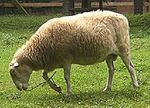
|
GEH: endangered |
D: 116 bucks / 3,056 floodplains (2014) |
| Carinthian sheep |

|
GEH: extremely endangered Austria ÖNGENE: highly endangered |
D: 42 bucks / 715 floodplains (2014) A: 4993 animals (Herd book 2010) |
| Linen sheep (old type) |
GEH: extremely endangered |
D: 68 bucks / 1,370 floodplains (2014) | |
| Linen sheep |

|
|
D: 67 bucks / 1,597 floodplains (2014) |
| Merino meat sheep |

|
GEH: endangered |
D: 171 bucks / 7,610 floodplains (2014) |
| Merino sheep |
|
D: 498 bucks / 14,776 floodplains (2014) | |
| Merino long wool sheep |
|
D: 52 bucks / 4,426 floodplains (2014) | |
| East Frisian milk sheep |

|
|
D: 217 bucks / 3,145 floodplains (2014) |
| Coarse-wooly Pomeranian landscape |

|
GEH: endangered |
D: 257 bucks / 3,616 floodplains (2014) |
| Rhön sheep |
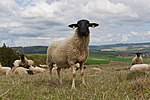
|
GEH: observation |
D: 230 bucks / 5,182 floodplains (2014) |
| Skudde |

|
GEH: endangered |
D: 258 bucks / 2,526 floodplains (2014) |
| Stone sheep: |

|
GEH: extremely endangered Austria ÖNGENE: highly endangered |
D: 76 bucks / 774 floodplains (2014) A: 438 animals (Herd book 2010) |
| Stone sheep: |

|
GEH Austria ÖNGENE: highly endangered |
D: 83 bucks / 672 floodplains (2014) A: 1,616 animals (herd book 2010) |
| Stone sheep: |

|
ÖNGENE: highly endangered |
A: 257 animals (Herd book 2010) |
| Stone sheep: |
ÖNGENE: endangered |
D: 4 bucks / 28 floodplains (2014) A: 1,909 animals (Herd book 2010) |
|
| Hungarian torch sheep |

|
ÖNGENE: highly endangered |
D: 9 bucks / 78 floodplains (2014) A: 280 animals (Herd book 2010) |
| Forest sheep |

|
GEH: highly endangered Austria ÖNGENE: highly endangered |
D: 76 bucks / 1,291 floodplains (2014) A: 1,582 animals (Herd book 2010) |
Pigs
| race | Illustration | Endangerment in Germany and Austria |
Existence in Germany and Austria |
|---|---|---|---|
| Angler saddle pig |

|
|
|
| Colorful Bentheim pig |
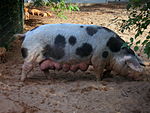
|
GEH: extremely endangered |
D: 88 boars / 350 sows (2014) |
| German landrace |
|
||
| German precious pig |
|
D: 166 boars / 3,835 sows (2014) | |
| German saddle pig |

|
GEH: extremely endangered |
D: 44 boars / 220 sows (2014) |
| Leicoma |

|
|
D: 5 boars / 19 sows (2014) |
|
Mangalitza pig (woolly pig ) |
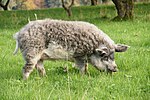
|
GEH: extremely endangered Austria ÖNGENE: highly endangered |
D: 57 boars / 167 sows (2014) A: 270 animals (Herdbook 2010) |
| The red-colored Husum pig |

|
|
D: 27 boars / 37 sows (2014) |
| Swabian-Hall pig |

|
GEH: endangered |
D: 30 boars / 329 sows (2014) |
| Turopolje pig |
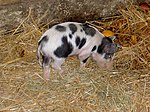
|
ÖNGENE: highly endangered |
A: 252 animals (Herd book 2010) |
Goats
| race | Illustration | Endangerment in Germany and Austria |
Existence in Germany and Austria |
|---|---|---|---|
| Colorful German noble goat (BDE) |

|
|
D: 221 bucks / 4,120 goats (2014) |
Colorful German noble goat (BDE)
|
GEH |
D: 7 bucks / 175 goats (2014) | |
Colorful German noble goat (BDE)
|

|
GEH |
without disclosures |
Colorful German noble goat (BDE)
|
GEH |
without disclosures | |
Colorful German noble goat (BDE)
|

|
GEH |
without disclosures |
| Bare goat |
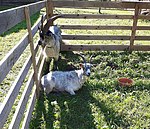
|
ÖNGENE: highly endangered (2010) |
88 (A, 2010) |
| Chamois-colored mountain goat |

|
ÖNGENE: endangered (2010) |
1.423 (A, 2010) |
| Girgentana goat |

|
|
D: 18 bucks / 36 goats (2014) |
| Peacock goat |
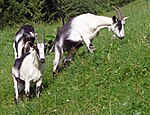
|
ÖNGENE: endangered |
D: 56 bucks / 169 goats (2014) A: 265 animals (Herd book 2010) |
| Pinzgauer radiant goat |
ÖNGENE: highly endangered |
A: 67 animals (Herd book 2010) | |
| Pinzgau goat |

|
ÖNGENE: highly endangered |
A: 417 animals (Herd book 2010) |
| Styrian piebald goat |
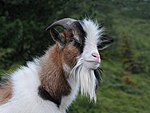
|
ÖNGENE: highly endangered |
A: 313 animals (Herd book 2010) |
| Tauern piebald goat |

|
ÖNGENE: highly endangered |
D: 21 bucks / 70 goats (2014) A: 811 animals (Herd book 2010) |
| Thuringian forest goat |
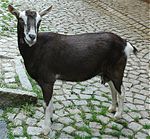
|
GEH: endangered |
D: 190 bucks / 1,376 goats (2014) |
| Four-horned goat |
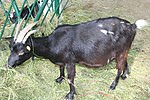
|
|
without disclosures |
| White German noble goat |

|
|
D: 209 bucks / 3,957 goats (2014) |
poultry
For the types of poultry, a “Common Red List of Old, Domestic and Endangered Poultry Breeds” has been agreed between the Federal Office for Agriculture and Food (BLE), the Association of German Racial Poultry Breeders (BDRG) and the Society for the Preservation of Old and Endangered Pet Breeds (GEH). In the "List of old indigenous poultry breeds in Germany" confirmed by the Advisory Board for Animal Genetic Resources in July 2012, only the original colors are listed. Races bred in Germany before 1930 that have or had a sustainable use are considered native.
The classification of all breeds into five hazard categories is based on the number of breeds (breeding lines or breeding pairs):
Without classification in endangerment categories, endangered breeds in Austria are supplemented by the Austrian National Association for Gene Reserves (ÖNGENE) and Arche Austria - Association for the Conservation of Rare Livestock Breeds . The breeds endangered in Switzerland according to ProSpecieRara , the Swiss Foundation for the cultural-historical and genetic diversity of plants and animals, are also added.
Chicken
| Race (color) |
Illustration | Endangerment of domestic domestic chickens |
Breeding population in 2013 in Germany |
|---|---|---|---|
| Altsteirer (wild brown, white) |

|
according to ÖNGENE , according to Arche Austria
|
D: 141 (141/638) of which 124/576 in wild brown and 17/62 in white |
|
Andalusian (blue-lined) |

|
|
D: 73 (73/222) |
| Appenzeller Barthuhn |
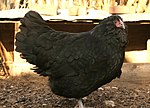
|
according to ProSpecieRara Switzerland |
without disclosures |
| Appenzell Pointed Hooded Chicken |

|
according to ProSpecieRara Switzerland |
without disclosures |
|
Augsburger (black) |
|
D: 36 (36/162) | |
|
Barnevelder (double hemmed) |
|
D: 331 (331 / 1.525) | |
|
Bergischer Kräher (black-golden brown dobbled ) |
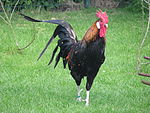
|
|
D: 62 (62/267) |
|
Bergischer Schlotterkamm (grooved, black, black and yellow doubled , black and white doubled ) |

|
|
D: 43 (43/200) |
|
Brakel (gold, silver) |
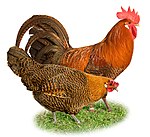
|
|
D: 191 (191/904) |
|
German salmon chicken (salmon-colored) |

|
|
D: 321 (321 / 1,379) |
|
German Langschan (blue-lined, black, white) |

|
|
D: 61 (61/223) |
|
German Reichshuhn (striped, red, white, white-black columbia) |

|
|
D: 177 (177/800) |
|
German Sparrowhawk (sperm) |

|
|
D: 141 (141/642) |
|
Dominican (cranked) |

|
|
D: 52 (52/255) |
|
Hamburger chicken (blue-lined, gold paint, gold sprinkles, black, silver paint, silver sprinkles, white) |

|
|
D: 273 (273 / 1.305) |
|
Italians (blue, yellow, striped, golden-brown-porcelain-colored, orange-necked, partridge-necked, red, red-saddled, black, black-and-white-pecked, white) |

|
|
D: 1,635 (1,635 / 9,158) |
|
Krüper (cuckoo, rebhuhnhalsig, black, black-weißgedoppelt, white) |

|
|
D: 76 (73/274) |
| Sheet fields |

|
|
D: 206 (206/860) |
|
Mechelner (pitted, white) |

|
|
D: 49 (49/226) |
|
Minorka (black, white) |

|
|
D: 72 (72/299) |
| Bareback chicken |

|
|
D: 66 (66/323) |
|
Orpington (blue-lined, brown-porcelain-colored, yellow, striped, partridge-colored banded, red, black, black-and-white checkered, white) |

|
|
D: 471 (471 / 1,654) |
|
East Frisian gull (gold-black flocked, silver-black flocked) |

|
|
D: 185 (185/791) |
|
Ramelsloher (yellow, white) |

|
|
D: 83 (83/306) |
|
Rhinelander (blue-lined, grouse-necked, partridge-necked, black, silver-necked, white) |
|
D: 471 (471 / 2.229) | |
|
Sachsenhuhn (porked, black, white, yellow) |
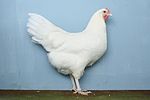
|
|
D: 91 (91/459) |
| Swiss chicken |

|
according to ProSpecieRara Switzerland |
without disclosures |
| Stoahendl , also Steinpiperl or Steinhendl |
according to alpenrassen.at |
100-200 animals (worldwide) | |
| Sulmtaler |

|
according to ÖNGENE , |
without disclosures |
|
Sundheimer (white-black columbia) |
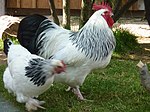
|
|
D: 234 (234/865) |
|
Thuringian Barthuhn (blue-lined, chamois-white-dabbed, yellow, creamed, gold-black-dotted, partridge-necked, black, silver-black-dotted, white) |
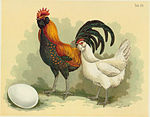
|
|
D: 265 (265 / 1,123) |
| Vorwerkhuhn |

|
|
D: 718 (718 / 3.141) |
|
Westphalian totleger (gold, silver) |

|
|
D: 250 (250 / 1,046) |
|
Wyandotten (blue, yellow, striped, gold-blue-lined, gold-necked, gold-black-lined, gold-white-lined, partridge-colored banded, red, black, black-white-spotted, silver-colored banded, silver-necked, silver-black-lined, white, white-black columbia) |

|
|
D: 784 (784 / 3.218) |
Geese
| Race (color) |
Illustration | Endangerment of domestic domestic geese |
Stock 2013 breeding (m / f) |
|---|---|---|---|
| Bavarian land goose |
|
D: 36 (33/45) | |
|
German laying goose (white) |
|
D: 60 (60/160) | |
|
Diepholzer Gans (white) |
|
D: 123 (123/240) | |
|
Emden goose (white) |
|
D: 91 (91/159) | |
| Land goose |
according to ÖNGENE , |
without disclosures | |
| Linen goose |
|
D: 75 (75/75) | |
|
Lip goose (white) |
|
D: 85 (85/85) | |
|
Pomeranian Goose (gray, gray-spotted, white) |

|
|
D: 592 (592 / 1,194) |
Ducks
| Race (color) |
Illustration | Endangerment of domestic domestic ducks |
Breeding stock 2013 in Germany |
|---|---|---|---|
|
Aylesbury Duck (white) |
|
D: 31 ( 31/60 ) | |
|
German Peking Duck (white) |

|
|
D: 147 ( 147/313 ) |
| Crested duck |

|
according to Arche Austria |
without disclosures |
|
High-brood ducks (blue, blue-yellow, black, black with bib, white, wild-colored, wild-colored with bib) |

|
|
D: 573 (573 / 1.029) |
|
Country duck with and without a hood (blue, yellow, black, black-spotted, black with white bib, white, wild-colored, wild-colored-spotted) |
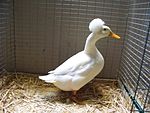
|
|
D: 147 (147/275) |
|
Runner ducks (brown, mottled with rehfarbig, black, white) |

|
|
D: 390 (390/823) |
|
Orpington (yellow) |
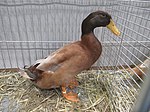
|
|
D: 110 ( 110/249 ) |
|
Pomeranian duck (blue, black) |

|
|
D: 170 ( 170/355 ) |
|
Rouenente (wild-colored) |

|
|
D: 84 ( 84/171 ) |
|
Warty duck (blue, blue-spotted, blue-wild-colored, brown-spotted, brown-wild-colored, black-spotted, white, wild-colored, wild-colored with bib) |
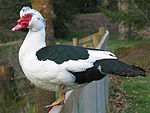
|
|
D: 1.006 (1.006 / 2.407) |
Turkeys
| German turkey color scheme |
Illustration | Endangerment of domestic turkeys |
Breeding stock 2013 in Germany |
|---|---|---|---|
|
German turkey (blue, yellow, copper-colored, red, black, white) |
|
D: 131 (131/312) (without bronze turkey and Cröllwitz turkey) |
|
| Blue turkey |
Cat. II, according to VHGW
|
without disclosures | |
| Bronze turkey |
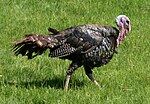
|
Cat. IV, according to VHGW |
D: 121 (121/231) |
| Cröllwitz turkey |
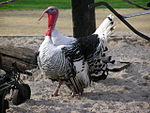
|
|
D: 187 (187/413) |
| Yellow turkey |
Cat. I, according to VHGW |
without disclosures | |
| Copper turkey |
Cat. II, according to VHGW |
without disclosures | |
| Red turkey |
Cat. II, according to VHGW |
without disclosures | |
| Black turkey |

|
Cat. I, according to VHGW |
without disclosures |
| White turkey |
Cat. I, according to VHGW |
without disclosures |
Pigeons
As a result of the further development of the method for risk assessment of small animals, indigenous pigeon breeds were recorded for the first time in Germany with the brochure "Indigenous farm animal breeds in Germany and the Red List of Endangered Farm Animal Breeds 2017". In relation to the original colors bred in Germany before 1930, none of them are endangered. Agricultural use for meat production is documented for the three of them:
| pigeon breed native to Germany | Illustration | Existence and endangerment |
|---|---|---|
|
Coburg larks
original colors:
|
3,393 pigeons / 3,409 pigeons / 602 breeders |
|
|
Lynx pigeons
original colors:
|
1,214 pigeons / 1,225 pigeons / 230 breeders |
|
|
Strasser original colors:
|
4,030 pigeons / 4,051 pigeons / 811 breeders |
Rabbits
The populations of all rabbit breeds bred in Germany were recorded for the first time in 2009 in a survey financed by the Federal Ministry of Food, Agriculture and Consumer Protection . However, they have not yet been classified into hazard categories. Only the Society for the Conservation of Old and Endangered Pet Breeds (GEH) carried out an (incomplete) classification.
In 2012 the BLE's Animal Genetic Resources Advisory Board decided to expand the area of responsibility of the “Poultry Working Group” to include the preservation of native rabbit breeds. A representative of the Central Association of German Racial Rabbit Breeders (ZDRK) was appointed to the working group, which was renamed the “Small Animal Working Group”. 29 breeds were identified in the working group by representatives of the ZDRK and the GEH as being native to Germany, i.e. H. already bred in Germany before 1949 with a sustainable use, identified. The classification of endangered rabbit breeds in the “Red List of Indigenous Livestock Breeds in Germany 2015” was initially based on the GEH hazard index (GKZ).
When calculating the hazard figure (GK), both the number of male (Nm) and female breeding animals (Nw) and the number of active breeders (NZ) are taken into account. With the weighting by a factor of 2, the special importance of the number of breeders is taken into account.
The endangerment categories are defined in the brochure "Native Livestock Breeds in Germany and the Red List of Endangered Livestock Breeds 2017":
| race | Illustration | Population numbers for breeding (Rammler / Häsinnen) 2013 in Germany , endangerment (domestic rabbit breeds ) |
|---|---|---|
|
Alaska
original colors:
|
2013: 1200 breeding (2061 rammers / 3694 rabbits) |
|
|
Angora rabbits
original colors:
|
2013: 151 breeders (233 bulls / 357 rabbits) |
|
|
German large silver
original colors:
|
2013: 178 farms (326 bucks / 556 the does) |
|
|
German giants
original colors:
|
2013: 1321 breeders (2383 rammers / 4107 rabbits) |
|
|
Giant German Checks
original colors:
|
2013: 664 breeders (1,310 bulls / 2,583 rabbits) |
|
|
German ram
Original colors:
blue, blue-white, chinchilla-colored, dark gray, iron-gray, iron-gray-white, rabbit-colored, black, black-white, white blue-eyes, white red-eyes, wild-colored, wild-colored-white |
2013: 935 breeders (1635 bulls / 2782 rabbits) |
|
|
English piebald
original colors:
|
2013: 547 breeders (1061 bulls / 2048 rabbits) |
|
|
English rams (according to German breeding standards) Original colors:
blue, blue-gray, dark gray, iron gray, yellow, black, Thuringian-colored, white roach, wild-colored |
2013: 110 breeders (137 bulls / 196 rabbits) |
|
|
Great Chinchilla
original colors:
|
2016: 475 breeders (814 bulls / 1,484 rabbits) |
|
|
Rabbit
original colors:
|
2013: 810 breeders (1382 bulls / 2314 rabbits) |
|
|
Havana
original colors:
|
2013: 711 breeders (1174 rammers / 1998 rabbits) |
|
|
Large light silver
original colors:
|
2013: 1,398 breeders (2,474 bucks / 4,338 rabbits) |
|
|
ermine
original colors:
|
2013: 1,023 breeders (2,041 rammers / 3,703 rabbits) |
|
|
Dutch
original colors:
blue-white, dark gray-white, iron gray-white, yellow-white, havanna-colored-white, black-white, thuringian-colored and white, wild-colored and white |
2013: 865 breeders (1525 bulls / 2865 rabbits) |
|
|
Japanese
original colors:
|
2013: 164 breeders (356 bulls / 692 rabbits) |
|
|
Little Chinchilla
original colors:
|
2013: 747 breeders (1219 bulls / 2113 rabbits) |
|
|
Small silver
original colors:
|
2013: 2953 breeders (5117 bulls / 8772 rabbits) |
|
|
Rabbit
original colors:
|
2013: 1920 breeding (3273 bulls / 5431 rabbits) |
|
|
Lux rabbit
original colors:
|
2013: 100 breeders (161 bulls / 268 rabbits) |
|
|
Marburg Feh
original colors:
|
2013: 650 breeders (1065 rammers / 1786 rabbits) |
|
|
Marten rabbit
original colors:
|
2013: 164 breeders (315 bulls / 487 rabbits) |
|
|
Meissner ram
original colors:
|
2013: 157 breedings (261 Rammler / 413 the does) |
|
|
Perlfeh
original colors:
|
2013: 444 breeders (755 bulls / 1,277 rabbits) |
|
|
Rex rabbit
Original colors:
Blue-Rexe, Castor-Rexe, Chin-Rexe, Feh-Rexe, Havanna-Rexe, Loh-Rexe, Lux-Rexe, Black-Rexe, White-Rexe |
2013: 2561 breeders (4309 bulls / 7346 rabbits) |
|
|
Rhenish piebalds
original colors:
|
2013: 201 breeders (438 bulls / 864 rabbits) |
|
|
Red New Zealanders
original colors:
|
2013: 1261 breeders (2114 rammers / 3725 rabbits) |
|
|
Russians
original colors:
|
2013: 541 breeders (912 bulls / 1,518 rabbits) |
|
|
Thuringian
original colors:
|
2013: 1,060 breeders (1,826 bulls / 3,169 rabbits) |
|
|
Viennese
original colors:
|
2013: 3,698 breeders (6,469 bulls / 1,1604 rabbits) |
dogs
| race | Illustration | Endangerment, existence |
|---|---|---|
| Old German herding dog : |
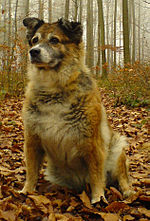
|
GEH: |
Old German herding dog :
|

|
GEH: |
| Old German herding dog : |

|
GEH: |
| Old German herding dog : |

|
GEH: |
| Old German herding dog : |
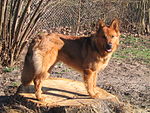
|
GEH: |
| Old German herding dog : |
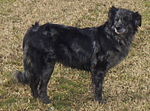
|
GEH: |
| Old German herding dog : |

|
GEH: |
| Großspitz |  |
Germany GEH: |
| Central point |  |
Germany GEH: |
| German pinscher |  |
Germany GEH: |
| Austrian pinscher | 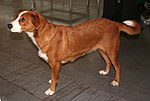 |
Austria Arche Austria: approx. 55 - 60 puppies per year (KÖP 2010 - 2014) |
Bees
| race | Illustration | Endangerment, existence |
|---|---|---|
| Dark European bee |

|
Cat. I (extremely endangered, according to GEH ); the ecotypes of heather bees , German brown bees and black alpine bees are considered to be extinct in Germany
|
| Carinthian bee |

|
according to ÖNGENE |
See also
Literature and web links
- Germany
- Federal Agency for Agriculture and Food (BLE): Indigenous livestock breeds in Germany and Red List of Endangered Livestock Breeds 2017. March 1, 2018. ( Document for download , PDF, 3 MB, not accessible)
- BLE: Central Documentation of Animal Genetic Resources in Germany (TGRDEU)
- Bund Deutscher Rassegewlügelzucher (BDRG), Society for the Conservation of Old and Endangered Pet Breeds (GEH): List of old native poultry breeds in Germany (PDF file)
- GEH: The Red List
- VIEH (Diverse Initiative for the Conservation of Endangered Pet Breeds) The Red List
- GENUVI (Society for International Livestock Breed Diversity in Germany eV)
- Austria
- Arche Austria : Red List of Endangered Animals in Austria. published by the Federal Ministry of Agriculture, Forestry, Environment and Water Management , Böhlau: Vienna 2010. ISBN 978-3-205-78480-7
- Austrian National Association for Genetic Reserves of Farm Animals (ÖNGENE): oengene.at (website)
- Arche Austria - Association for the Conservation of Rare Livestock Breeds: arche-austria.at (website)
- Club for Austrian Pinchers : oe-pinscher-klub.at (website)
- Switzerland
- ProSpecieRara Switzerland: 28 supervised breeds
Individual evidence
- ↑ a b What is the GEH Red List? (No longer available online.) In: www.geh.de. Archived from the original on February 22, 2017 ; Retrieved April 4, 2016 . Info: The archive link was inserted automatically and has not yet been checked. Please check the original and archive link according to the instructions and then remove this notice.
- ↑ a b Central Documentation of Animal Genetic Resources in Germany. genres.de, archived from the original on April 15, 2005 ; Retrieved June 19, 2009 .
- ↑ a b Federal Office for Agriculture and Food: Red list of endangered domestic livestock breeds in Germany (PDF file; 460 kB; as of April 2008)
- ↑ Red List of Vieh eV
- ↑ Stock figures of the Vieh eV
- ↑ oengene
- ↑ arche-austria
- ^ Federal Agency for Agriculture and Food: Red List of Indigenous Livestock Breeds in Germany. Edition December 2013, p. 111 ( online ( memento of the original dated February 1, 2014 in the Internet Archive ) Info: The archive link has been inserted automatically and has not yet been checked. Please check the original and archive link according to the instructions and then remove this note .; PDF )
- ↑ Table 2: Number of domestic livestock breeds in the endangerment categories. In: Federal Agency for Agriculture and Food: Red list of domestic livestock breeds in Germany. Edition December 2013, p. 111 ( online ( memento of the original dated February 1, 2014 in the Internet Archive ) Info: The archive link has been inserted automatically and has not yet been checked. Please check the original and archive link according to the instructions and then remove this note .; PDF )
- ^ Federal Agency for Agriculture and Food: Red List of Indigenous Livestock Breeds in Germany. Edition December 2013, pp. 15–18 ( online ( memento of the original dated February 1, 2014 in the Internet Archive ) Info: The archive link was inserted automatically and has not yet been checked. Please check the original and archive link according to the instructions and then remove this notice. ; PDF)
- ↑ oengene.at
- ↑ geh.de
- ↑ a b c d e f g h i j k l m n o p tgrdeu.genres.de
- ↑ geh.de
- ↑ oengene.at
- ↑ geh.de
- ↑ geh.de
- ↑ oengene.at
- ↑ oengene.at
- ↑ geh.de
- ↑ geh.de
- ↑ geh.de
- ↑ geh.de
- ↑ geh.de
- ↑ geh.de
- ↑ geh.de
- ↑ oengene.at
- ↑ a b c d e f g h i j k l m n o p q tgrdeu.genres.de
- ↑ geh.de
- ↑ geh.de
- ↑ geh.de
- ↑ geh.de
- ↑ geh.de
- ↑ oengene.at
- ↑ geh.de
- ↑ geh.de
- ↑ geh.de
- ↑ oengene.at
- ↑ geh.de
- ↑ oengene.at
- ↑ geh.de
- ↑ geh.de
- ↑ oengene.at
- ↑ geh.de
- ↑ oengene.at
- ↑ oengene.at
- ↑ geh.de
- ↑ geh.de
- ↑ oengene.at
- ↑ oengene.at
- ↑ geh.de
- ↑ oengene.at
- ↑ geh.de
- ↑ a b c d e f g h i j k l m n o p q r s t u v w x y z tgrdeu.genres.de
- ↑ geh.de
- ↑ oengene.at
- ↑ geh.de
- ↑ geh.de
- ↑ geh.de
- ↑ geh.de
- ↑ geh.de
- ↑ geh.de
- ↑ oengene.at
- ↑ geh.de
- ↑ geh.de
- ↑ geh.de
- ↑ geh.de
- ↑ geh.de
- ↑ geh.de
- ↑ a b oengene.at
- ↑ geh.de
- ↑ oengene.at
- ↑ oengene.at
- ↑ oengene.at
- ↑ geh.de
- ↑ oengene.at
- ↑ Federal Office for Agriculture and Food (Ed.): Indigenous farm animal breeds in Germany and Red List of Endangered Farm Animal Breeds 2017 . BMEL, March 1, 2018 (212 pp., Ble.de [PDF; 3.0 MB ; accessed on April 16, 2018] 5th edition of the list of domestic livestock breeds and their endangerment categories, first published in 2008).
- ↑ geh.de
- ↑ a b c d e f tgrdeu.genres.de
- ↑ geh.de
- ↑ oengene.at
- ↑ geh.de
- ↑ geh.de
- ↑ geh.de
- ↑ geh.de
- ↑ oengene.at
- ↑ a b Appendix 1: List of indigenous farm animal breeds and their endangerment categories from the Animal Genetic Resources Advisory Board. In: Federal Office for Agriculture and Food: Red List: Indigenous farm animal breeds in Germany 2013. P. 171–175 ( online ( Memento of the original from February 1, 2014 in the Internet Archive ) Info: The archive link was inserted automatically and has not yet been checked. Please check the original and archive link according to the instructions and then remove this note .; PDF)
- ↑ a b c d e f g tgrdeu.genres.de
- ↑ geh.de
- ↑ geh.de
- ↑ geh.de
- ↑ geh.de
- ↑ oengene.at ÖNGENE
- ↑ arche-austria.at
- ↑ oengene.at ÖNGENE
- ↑ arche-austria.at
- ↑ geh.de
- ↑ oengene.at
- ↑ oengene.at
- ↑ arche-austria.at
- ↑ oengene.at
- ↑ arche-austria.at
- ↑ oengene.at
- ↑ arche-austria.at
- ↑ oengene.at
- ↑ arche-austria.at
- ↑ geh.de
- ↑ Federal Office for Agriculture and Food: Red List of Endangered Indigenous Livestock Breeds in Germany. Edition 2010, p. 106 ( online ( memento of the original from July 18, 2011 in the Internet Archive ) Info: The archive link has been inserted automatically and has not yet been checked. Please check the original and archive link according to the instructions and then remove this note .; PDF; 1.85 MB)
- ↑ a b c d List of old native poultry breeds in Germany ( Memento of the original from January 2, 2016 in the Internet Archive ) Info: The archive link was inserted automatically and has not yet been checked. Please check the original and archive link according to the instructions and then remove this notice. (PDF; 124 kB), as of July 30, 2012
- ↑ Classification in the list of old native poultry breeds. In: Red List of Indigenous Livestock Breeds in Germany 2015 ( Memento of the original from December 30, 2015 in the Internet Archive ) Info: The archive link was inserted automatically and has not yet been checked. Please check the original and archive link according to the instructions and then remove this notice. (PDF), p. 151.
- ↑ Table 4: Classification in the list of old, native poultry breeds in Germany. (Status 2009) In: Federal Agency for Agriculture and Food: Red List: Indigenous farm animal breeds in Germany. Edition December 2013, p. 162 ( online ( Memento of the original from February 1, 2014 in the Internet Archive ) Info: The archive link was automatically inserted and not yet checked. Please check the original and archive link according to the instructions and then remove this note .; PDF )
- ↑ a b c d Table 4: Population numbers of native poultry breeds in 2013 (only native colors were taken into account). In: Federal Agency for Agriculture and Food: Red List of Indigenous Livestock Breeds in Germany 2015. , pp. 154–156 ( online ( memento of the original dated December 30, 2015 in the Internet Archive ) Info: The archive link has been inserted automatically and has not yet been checked. Please check the original and archive link according to the instructions and then remove this note .; PDF)
- ↑ a b c d e f Mareike Fellmin, Miriam Elsässer: Kyroreserve at the chicken - the project year 2013 . In: poultry newspaper . No. 24 , 2013, p. 20-22 .
-
↑ Günter Jaritz: stone chicken or Stoapipal. In: altsteirerweiss.at. Jakob Günther, 2014, accessed on November 9, 2014 . Günter Jaritz, Unken: Documentation Steinhendl. (PDF file) In: alpenrassen.at. 2014, Retrieved November 9, 2014 (683 KB). de Wiskentale: Original farm animal breeds in Austria. Domestic chicken breeds. (No longer available online.) In: Arche-Hof De Wiskentale. Archived from the original on June 29, 2012 ; Retrieved November 9, 2014 . Info: The archive link was inserted automatically and has not yet been checked. Please check the original and archive link according to the instructions and then remove this notice.
- ↑ Federal Office for Agriculture and Food (Ed.): Indigenous farm animal breeds in Germany and Red List of Endangered Farm Animal Breeds 2017 . BMEL, March 1, 2018, foreword, p. 4–6 (212 pp., Ble.de [PDF; 3.0 MB ; accessed on April 16, 2018] 5th edition of the list of domestic livestock breeds and their endangerment categories, first published in 2008).
- ↑ a b Federal Office for Agriculture and Food (Ed.): Indigenous farm animal breeds in Germany and Red List of Endangered Farm Animal Breeds 2017 . BMEL, March 1, 2018, indigenous pigeon breeds, p. 161–163 (212 pp., Ble.de [PDF; 3.0 MB ; accessed on April 16, 2018]).
- ↑ Endangering domestic farm animal breeds - rabbits. In: Federal Office for Agriculture and Food: Red list of endangered domestic livestock breeds in Germany. Edition 2010, pp. 127–129 ( online ( memento of the original from July 18, 2011 in the Internet Archive ) Info: The archive link has been inserted automatically and has not yet been checked. Please check the original and archive link according to the instructions and then remove this note .; PDF; 1.85 MB)
- ↑ Federal Agency for Agriculture and Food [BLE] (Ed.): Red List of Indigenous Livestock Breeds in Germany 2015 . 2015, Endangering domestic farm animal breeds - rabbits, p. 157 ff .
- ↑ Federal Agency for Agriculture and Food [BLE] (Ed.): Red List of Indigenous Livestock Breeds in Germany 2015 . 2015, classification in the list of old native rabbit breeds in Germany, p. 189-191 .
- ↑ Karola Stier: The red list of endangered livestock breeds of the GEH. In: geh.de. Society for the Preservation of Old and Endangered Pet Breeds (GEH), accessed on January 1, 2016 (formula of the GEH risk indicator GKZ).
- ↑ a b Federal Office for Agriculture and Food (Ed.): Indigenous farm animal breeds in Germany and Red List of Endangered Farm Animal Breeds 2017 . BMEL, March 1, 2018, indigenous pigeon breeds, p. 169–199 (212 pp., Ble.de [PDF; 3.0 MB ; accessed on April 16, 2018]).
- ↑ Federal Agency for Agriculture and Food [BLE] (Ed.): Red List of Indigenous Livestock Breeds in Germany 2015 . 2015, Table 6: Population numbers of native rabbit breeds 2013, p. 190 f .
- ↑ geh.de
- ↑ a b c d e f g g-eh.de
- ↑ a b g-eh.de
- ↑ geh.de
- ↑ oe-pinscher-klub.at
- ↑ arche-austria.at
